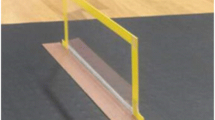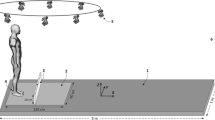Abstract
The purpose of this study was to explore the mechanism of anticipatory control of gait in relation to the perception of an obstacle. Typically developing (TD) children (4–7 years of age) and children with Down syndrome (5–6 years of age) walked and stepped over obstacles of two different heights—a “subtle” obstacle that was placed at a very low distance from the floor (1% of total body height) and an “obvious” obstacle that was placed at a much higher distance from the floor (15% of total body height). Spatial and temporal measures of the gait cycle were analyzed. TD children showed increased variability in pre-obstacle step lengths only in response to the higher obstacle. Children with DS showed a decrease in variability in response to the higher obstacle and marked qualitative changes in their gait cycle. Both groups of children were able to scale toe clearance with obstacle height. These results show that TD young children can make task-specific anticipatory adjustments by modulating step length and toe clearance. Children with DS show appropriate scaling of toe clearance and are beginning to show the emergence of anticipatory responses under specific environmental conditions.



Similar content being viewed by others
References
Charlton J, Ibsen E, Lavelle BM (2000) Control of manual skills in children with Down Syndrome. In: Weeks DJ, Chua R, Elliott D (eds) Perceptual-motor behavior in Down syndrome. Human kinetics, Champaign, IL, pp 151–174
Henderson SE, Morris J, Frith U (1981) The motor deficit of Down’s syndrome children: a problem of timing? J Child Psychol Psychiatry 22:233–245
Ledebt A, Bril B, Breniere Y (1998) The build-up of anticipatory behaviour. An analysis of the development of gait initiation in children. Exp Brain Res 120:9–17
McFadyen BJ, Winter DA (1991) Anticipatory locomotor adjustments during obstructed human walking. Neurosci Res Commun 9:37–44
McFadyen BJ, Malouin, F, Dumas, F (2001) Anticipatory locomotor control for obstacle avoidance in mid-childhood aged children. Gait Posture 13:7–16
Patla AE, Rietdyk S (1993) Visual control of limb trajectory over obstacles during locomotion: effect of obstacle height and width. Gait Posture 1:45–60
Patla AE, Vickers JN (1997) Where and when do we look as we approach and step over an obstacle in the travel path? Neuroreport 8:3661–3665
Patla AE, Robinson C, Samways M, Armstrong CJ (1989) Visual control of step length during overground locomotion: task-specific modulation of the locomotor synergy. J Exp Psychol Hum Percept Perform 15:603–617
Pryde KM, Roy EA, Patla AE (1997) Age-related trends in locomotor ability and obstacle avoidance. Hum Mov Sci 16:507–516
Savelsbergh G, van der Kamp J, Ledebt A, Planinsek T (2000) Information-movement coupling in children with Down syndrome. In Weeks DJ, Chua R, Elliott D (eds) Perceptual-motor behavior in Down syndrome. Human Kinetics, Champaign, IL, pp 151–174
Sparrow WA, Shinkfield AJ, Summers JJ (1998) Gait characteristics in individuals with mental retardation: unobstructed level-walking, negotiating obstacles, and stair climbing. Hum Mov Sci 17:167–187
Taga G (1998) A model of the neuro-musculo-skeletal system for anticipatory adjustment of human locomotion during obstacle avoidance. Biol Cybern 78:9–17
Acknowledgements
The authors are grateful to the children and their parents for their participation. This work was supported by the Queen Alexandra Foundation.
Author information
Authors and Affiliations
Corresponding author
Rights and permissions
About this article
Cite this article
Virji-Babul, N., Brown, M. Stepping over obstacles: anticipatory modifications in children with and without Down syndrome. Exp Brain Res 159, 487–490 (2004). https://doi.org/10.1007/s00221-004-1971-5
Received:
Accepted:
Published:
Issue Date:
DOI: https://doi.org/10.1007/s00221-004-1971-5




